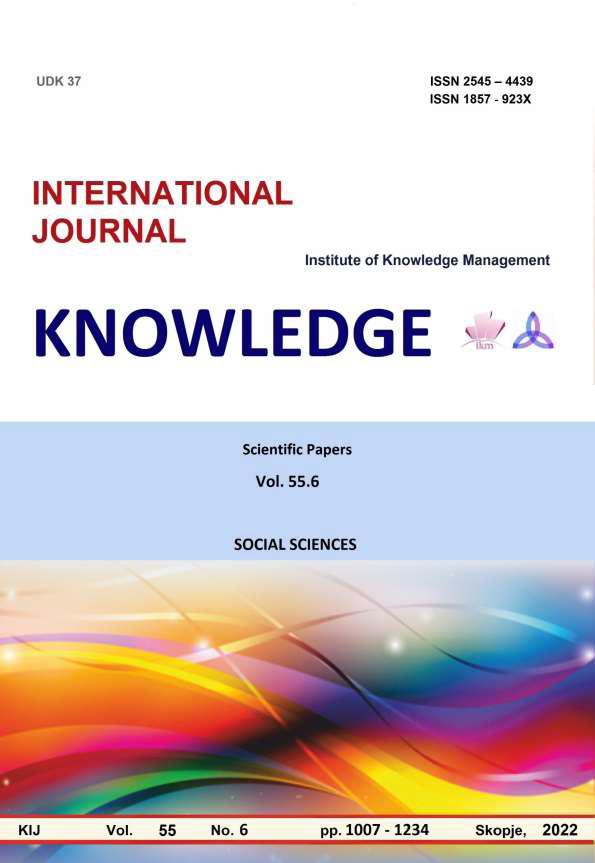ASSESSING THE INFLUENCE OF THE EUROPEAN STRUCTURAL AND INVESTMENT FUNDS ON ECONOMIC CONVERGENCE IN THE EUROPEAN UNION
Keywords:
European structural and investment funds, economic development, beta-convergence, causality, panel dataAbstract
The European structural and investment funds are an essential tool for achieving one of the main
European economic objectives - economic and social convergence between the member states of the European
Union. The article evaluates the dependence and causality between fund payments and regional economic cohesion
in the period 2014-2020. The indicators used to measure the various aspects of the impact of the European structural
and investment funds are: the EU payments for ESIF, the EU payments for ESIF adjusted for corruption perception
index, human capital index, population growth and gross domestic savings. Economic development is measured by
gross domestic product per capita. The process of regional economic convergence is studied through the approaches
of absolute and conditional beta-convergence. Absolute beta-convergence is achieved when the territorial units
converge to a certain level, regardless of the differences in their initial values. Conditional beta-convergence allows
for the presence of various factors (structural variables) that influence the convergence process. Panel regression
equations of absolute and conditional beta-convergence were estimated using pooled OLS, fixed-effects and
random-effects models. Causality between the variables included in the empirical study was examined using the
non-causality Granger test for heterogeneous panel data models, developed by Dumitrescu and Hurlin. As a result of
the empirical research, a reduction of the differences in economic development between the EU countries was
found, as well as the direction and strength of influence of the structural variables for the convergence process.
Based on the Dumitrescu-Hurlin causality test, both the presence of one-way and two-way causal relationships, as
well as the absence of causality between some of the indicators, were established.
References
Antunes, M., Viegas, M., Varum, C., & Pinho, C. (2020). The Impact of Structural Funds on Regional Growth: A Panel Data Spatial Analysis. Intereconomics, 55(5), 312-319.
Baltagi, B. (2005). Econometric Analysis of Panel Data, 3rd ed. Chichester: John Wiley & Sons Ltd.
Barro, R. J., Sala-i-Martin, X., Blanchard, O. J., & Hall, R. E. (1991). Convergence across states and regions. Brookings papers on economic activity, 107-182.
Becker, S. O., Egger, P. H., & Von Ehrlich, M. (2018). Effects of EU regional policy: 1989-2013. Regional Science and Urban Economics, 69, 143-152.
Bussoletti, S., & Esposti, R. (2004). Regional Convergence, Structural Funds and the Role of Agricolture in the EU. A Panel-Data Approach (No. 220).
Cappelen, A., Castellacci, F., Fagerberg, J., & Verspagen, B. (2003). The impact of EU regional support on growth and convergence in the European Union. JCMS: Journal of Common Market Studies, 41(4), 621-644.
Crescenzi, R., Di Cataldo, M., & Rodríguez‐Pose, A. (2016). Government quality and the economic returns of transport infrastructure investment in European regions. Journal of Regional Science, 56(4), 555-582.
Croissant, Y., & Millo, G. (2018). Panel data econometrics with R. John Wiley & Sons.
Dall'Erba, S., & Le Gallo, J. (2008). Regional convergence and the impact of European structural funds over 1989–1999: A spatial econometric analysis. Papers in Regional Science, 87(2), 219-244.
Dumitrescu, E. I., & Hurlin, C. (2012). Testing for Granger non-causality in heterogeneous panels. Economic modelling, 29(4), 1450-1460.
Ederveen, S., Gorter, J., Mooij, R. D., & Nahuis, R. (2003). Funds and Games: The Economics of European Cohesion Policy. ENEPRI Occasional Paper No. 3, October 2003.
Ederveen, S., De Groot, H. L., & Nahuis, R. (2006). Fertile soil for structural funds? A panel data analysis of the conditional effectiveness of European cohesion policy. Kyklos, 59(1), 17-42.
Fiaschi, D., Lavezzi, A. M., & Parenti, A. (2018). Does EU cohesion policy work? Theory and evidence. Journal of Regional Science, 58(2), 386-423.
Maynou, L., Saez, M., Kyriacou, A., & Bacaria, J. (2016). The impact of structural and cohesion funds on Eurozone convergence, 1990–2010. Regional Studies, 50(7), 1127-1139.
Mohl, P., & Hagen, T. (2010). Do EU structural funds promote regional growth? New evidence from various panel data approaches. Regional Science and Urban Economics, 40(5), 353-365.
Rodríguez-Pose, A., & Garcilazo, E. (2015). Quality of government and the returns of investment: Examining the impact of cohesion expenditure in European regions. Regional Studies, 49(8), 1274-1290.
Scotti, F., Flori, A., & Pammolli, F. (2022). The economic impact of structural and Cohesion Funds across sectors: Immediate, medium-to-long term effects and spillovers. Economic Modelling, 111, 105833.
Петков, П. (2020). Иконометрия с Gretl. Свищов, АИ" Ценов





